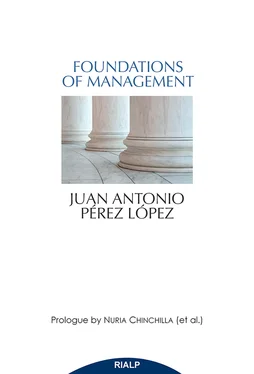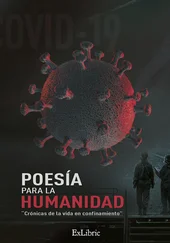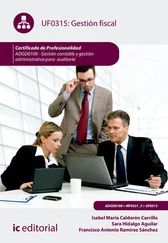We mention these extreme cases because they may help us gain insight into one aspect of a good understanding of real organizations; those which exist and are in operation, or those that may appear in reality at any time.
This aspect is the following: it is not enough merely to be possible (i.e., not contradictory or utopian) for a particular organization to actually exist. In order for an organization to exist and operate, three basic factors are required:
1. The formulation of certain goals or results which may be effectively achieved by implementing the production system, and whose achievement would enable the incentive
system to be implemented so that people will be satisfied:so that they actually receive what they expect from the organization.
2. That the people acting in the organization can do what the production system requires them to do.
3. That they actually want to do what the production system requires them to do.
These three points summarize what are considered to be the basic functions or tasks of an organization's managers: the body that governs an organization. Although they can be defined in a number of ways, they are usually given the following names:
1. Operational definition of purpose, which specifies the results to be achieved by the organization and how the organization's members must act in order to achieve them.
2. Structuring the definition of purpose: that is, finding the persons who can perform the different tasks specified by the operational definition and assigning the corresponding task to each of them.
3. Implementing the purpose: that is, making sure that each organization member is actually motivated to perform the tasks assigned to him.
Elements of the real organization
We have seen that for a formal organization to exist in reality—to be a real organization—the results it intends to achieve must be explicitly defined (operational definition of purpose), each of the participants in the organization must know what he has to do (structuring the definition of purpose) and must want to do it (implementation of purpose).
These three processes—which we will call definition of purpose, communication and motivation, respectively—may be very simple or very complex. In an ephemeral organization, such as the one we mentioned previously (the group of people who agree to take a taxi so that they can get home sooner), these processes scarcely exist, occurring at the same time and with very little prior discussion.
In stable organizations which are expected to last for a longer period, the function of what we call management is to arrange matters so that these three processes are properly executed, because the survival of the real organization depends on them. Any serious error in the definition of purpose, communication or motivation will cause the organization to disappear. These processes are the true vital processes of any real organization.
We said previously that all the interactions that occur among the members of the organization are to be found in the real organization. We have included in what we called the informal or spontaneous organization those interactions which are not regulated by the formal system. Therefore, we can also say that in so far as these informal interactions influence those three vital processes, they will be interactions that affect the life of the organization, although they may not be defined or regulated in any formal manner. Of course, there will also be many other interactions in this spontaneous or informal world that have very little or no bearing on the organization's operation. The criterion for defining whether they have any importance has to be that of their possible influence on these basic processes. This criterion is not easy to apply.
For example, if two employees working together in a company department are football fans, there is no doubt that they will interact quite a lot by talking about the subject. At first sight, it would appear that these interactions would have little or no effect on the organization's functioning. In most cases, this may be so, but it would be advisable to bear in mind that this fact might have some influence on either communication or motivation (it would not be the first time a manager had problems trying to get certain employees to do some extra work the day after their local team has been beaten).
The example is a trivial one, but precisely for this reason it shows how apparently trivial things may come to affect the organization's vital processes. For these processes are truly vital, not only in so far as they determine the organization's life, but also in that other primary meaning we refer to when, in our attempts to express a complex reality, we say that it is “life itself’.
In a living, existing organization, the definition of purpose, communication, and motivation is not something done once and for all, nor only at certain times in accordance with a schedule. Rather, it is a continuous process. An organization is always defining purposes (identifying things that have to be done), communicating and motivating.
This should not be understood to mean that the organization is always changing its purposes, what it has to communicate, or the way it motivates: those kinds of changes are rather the exception, like social revolutions. The statement should be understood to mean that certain general purposes become more specific, and that more precise definitions are given regarding what should be done under the circumstances currently prevailing; refinements of the purpose along those lines must be communicated individually, and motivation also has to be secured in order for the organization to continue its operations.
Theories or models for explaining organizations
Even a superficial analysis of the processes of purpose definition, communication and motivation shows that, besides the difficulties that each raises in its own right, all are also substantially complicated by their mutual interdependence. Thus, it is apparent that:
a) The quality of the definition of purpose will affect the extent to which the needs of the organization’s members can be satisfied. On the other hand, however, the satisfaction of needs is a driving force in motivating individuals to cooperate with the organization.
b) The definition of purpose determines the actions that must be coordinated, which means that any refinement or development of the purpose implies a development of the communication process.
c) The performance of specific tasks required of members will, in turn, affect their motivation to cooperate.
Given all these complications, it is not surprising that simplified models or images of reality have been devised in order to improve our understanding. These models have become the rationale for different theories that have been formulated about human organizations.
Leaving aside the secondary differences which do not affect the primary concepts we are dealing with, there are only three major groups of theories or models—three paradigms—to explain the behavior of organizations. These are:
- Mechanical models (the organization as a technical system)
- Organic models (the organization as an organism)
- Anthropological models (the organization as an institution)
A human organization is an anthropological reality: that is, a group of people who have come together to do something jointly. However, it is sometimes useful to represent this
reality through a simplified image—to reduce it to a model that leaves out some of its aspects--in order to analyze others in greater detail (the process is like the one we use when we analyze a map instead of studying a piece of land on site).
This reduced representation must be treated with great care, with full awareness of that which has not been included in it and of the difficulties that may arise interpreting, in reality, what has been found through analysis of the model.
Читать дальше












